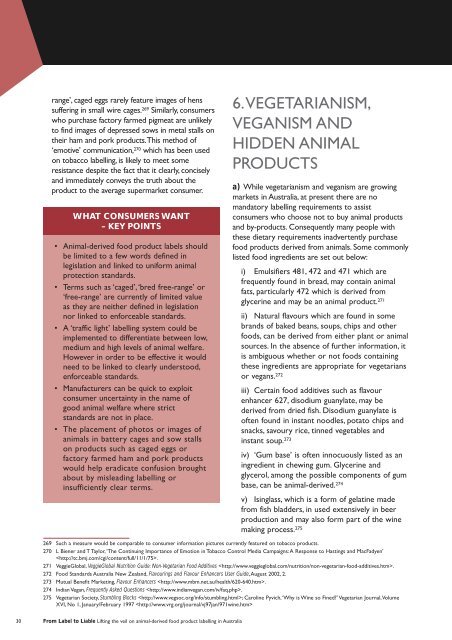From Label to Liable: Scams, Scandals and Secrecy - Voiceless
From Label to Liable: Scams, Scandals and Secrecy - Voiceless
From Label to Liable: Scams, Scandals and Secrecy - Voiceless
Create successful ePaper yourself
Turn your PDF publications into a flip-book with our unique Google optimized e-Paper software.
ange’, caged eggs rarely feature images of hens<br />
suffering in small wire cages. 269 Similarly, consumers<br />
who purchase fac<strong>to</strong>ry farmed pigmeat are unlikely<br />
<strong>to</strong> find images of depressed sows in metal stalls on<br />
their ham <strong>and</strong> pork products. This method of<br />
‘emotive’ communication, 270 which has been used<br />
on <strong>to</strong>bacco labelling, is likely <strong>to</strong> meet some<br />
resistance despite the fact that it clearly, concisely<br />
<strong>and</strong> immediately conveys the truth about the<br />
product <strong>to</strong> the average supermarket consumer.<br />
WHAT CONSUMERS WANT<br />
– KEY POINTS<br />
• Animal-derived food product labels should<br />
be limited <strong>to</strong> a few words defined in<br />
legislation <strong>and</strong> linked <strong>to</strong> uniform animal<br />
protection st<strong>and</strong>ards.<br />
• Terms such as ‘caged’, ‘bred free-range’ or<br />
‘free-range’ are currently of limited value<br />
as they are neither defined in legislation<br />
nor linked <strong>to</strong> enforceable st<strong>and</strong>ards.<br />
• A ‘traffic light’ labelling system could be<br />
implemented <strong>to</strong> differentiate between low,<br />
medium <strong>and</strong> high levels of animal welfare.<br />
However in order <strong>to</strong> be effective it would<br />
need <strong>to</strong> be linked <strong>to</strong> clearly unders<strong>to</strong>od,<br />
enforceable st<strong>and</strong>ards.<br />
• Manufacturers can be quick <strong>to</strong> exploit<br />
consumer uncertainty in the name of<br />
good animal welfare where strict<br />
st<strong>and</strong>ards are not in place.<br />
• The placement of pho<strong>to</strong>s or images of<br />
animals in battery cages <strong>and</strong> sow stalls<br />
on products such as caged eggs or<br />
fac<strong>to</strong>ry farmed ham <strong>and</strong> pork products<br />
would help eradicate confusion brought<br />
about by misleading labelling or<br />
insufficiently clear terms.<br />
6. VEGETARIANISM,<br />
VEGANISM AND<br />
HIDDEN ANIMAL<br />
PRODUCTS<br />
a) While vegetarianism <strong>and</strong> veganism are growing<br />
markets in Australia, at present there are no<br />
m<strong>and</strong>a<strong>to</strong>ry labelling requirements <strong>to</strong> assist<br />
consumers who choose not <strong>to</strong> buy animal products<br />
<strong>and</strong> by-products. Consequently many people with<br />
these dietary requirements inadvertently purchase<br />
food products derived from animals. Some commonly<br />
listed food ingredients are set out below:<br />
i) Emulsifiers 481, 472 <strong>and</strong> 471 which are<br />
frequently found in bread, may contain animal<br />
fats, particularly 472 which is derived from<br />
glycerine <strong>and</strong> may be an animal product. 271<br />
ii) Natural flavours which are found in some<br />
br<strong>and</strong>s of baked beans, soups, chips <strong>and</strong> other<br />
foods, can be derived from either plant or animal<br />
sources. In the absence of further information, it<br />
is ambiguous whether or not foods containing<br />
these ingredients are appropriate for vegetarians<br />
or vegans. 272<br />
iii) Certain food additives such as flavour<br />
enhancer 627, disodium guanylate, may be<br />
derived from dried fish. Disodium guanylate is<br />
often found in instant noodles, pota<strong>to</strong> chips <strong>and</strong><br />
snacks, savoury rice, tinned vegetables <strong>and</strong><br />
instant soup. 273<br />
iv) ‘Gum base’ is often innocuously listed as an<br />
ingredient in chewing gum. Glycerine <strong>and</strong><br />
glycerol, among the possible components of gum<br />
base, can be animal-derived. 274<br />
v) Isinglass, which is a form of gelatine made<br />
from fish bladders, in used extensively in beer<br />
production <strong>and</strong> may also form part of the wine<br />
making process. 275<br />
269 Such a measure would be comparable <strong>to</strong> consumer information pictures currently featured on <strong>to</strong>bacco products.<br />
270 L Biener <strong>and</strong> T Taylor, ‘The Continuing Importance of Emotion in Tobacco Control Media Campaigns: A Response <strong>to</strong> Hastings <strong>and</strong> MacFadyen’<br />
.<br />
271 VeggieGlobal, VeggieGlobal Nutrition Guide: Non-Vegetarian Food Additives .<br />
272 Food St<strong>and</strong>ards Australia New Zeal<strong>and</strong>, Flavourings <strong>and</strong> Flavour Enhancers User Guide, August 2002, 2.<br />
273 Mutual Benefit Marketing, Flavour Enhancers .<br />
274 Indian Vegan, Frequently Asked Questions .<br />
275 Vegetarian Society, Stumbling Blocks ; Caroline Pyvich, ‘Why is Wine so Fined’ Vegetarian Journal, Volume<br />
XVI, No 1, January/February 1997 <br />
30<br />
<strong>From</strong> <strong>Label</strong> <strong>to</strong> <strong>Liable</strong> Lifting the veil on animal-derived food product labelling in Australia


